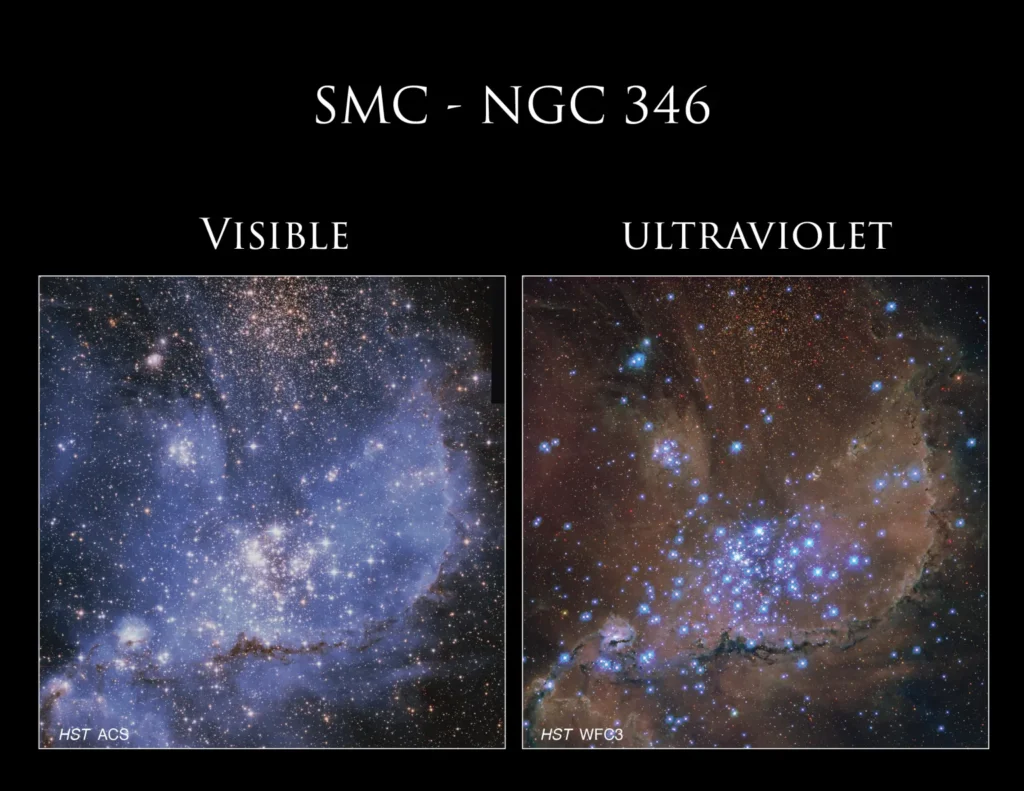In a stunning new image, NASA’s Hubble Space Telescope reveals the ultraviolet glow of NGC 346, a star cluster in the Small Magellanic Cloud, one of the Milky Way’s closest neighbors. With its glowing purplish stars, this vibrant snapshot showcases Hubble’s ability to uncover hidden cosmic wonders. But it’s not just about beauty—this view holds key insights into star formation and the early universe. Here’s why scientists are so excited.
A Star Cluster in Our Backyard
NGC 346, located around 210,000 light-years away in the SMC, is one of the most energetic star-forming regions in the universe. The Small Magellanic Cloud, a satellite galaxy to the Milky Way, hosts a collection of hot, massive stars in this cluster, which are unleashing powerful radiation and high-energy outflows.
These outflows have the ability to erode dense gas and dust in the surrounding nebula, N66, helping to shape the interstellar medium and drive the cycle of star formation.
Astronomers believe that more than half of the known high-mass stars in the SMC are located within NGC 346, making it a rich laboratory for studying how stars form and evolve in a low-metallicity environment—an environment that mirrors conditions in the early universe.

NASA, ESA, A. James (STScI), and C. Murray (Space Telescope Science Institute); Image Processing: Gladys Kober (NASA/Catholic University of America)
With Hubble’s ultraviolet imaging, we can see these powerful stars more clearly than ever before, helping scientists unlock the secrets of stellar birth and the development of galaxies.
Why Ultraviolet Light Matters
So, what makes this ultraviolet view so important? Ultraviolet light is a key tool in observing young, hot stars that emit high levels of energy. However, because Earth’s atmosphere absorbs most ultraviolet radiation, ground-based telescopes cannot capture these observations.
This is where Hubble shines. Positioned above our atmosphere, Hubble has the unique ability to capture ultraviolet light, giving us a clearer picture of how stars like those in NGC 346 are shaping their environment.
In visible light, NGC 346 is already impressive, with bright stars embedded in blue nebulosity. But in ultraviolet light, the cluster transforms into something even more spectacular, as glowing stars dominate the image’s center, surrounded by dark ridges of gas and dust.
Ultraviolet observations are especially valuable in regions like the SMC, where the low-metallicity environment reflects the conditions that were prevalent in the early universe. By studying these regions, scientists gain insights into how stars formed when the universe was still young and heavy elements were scarce.
Unraveling the Early Universe
One of the reasons astronomers are so excited about this observation is because NGC 346 offers a window into the early universe. In astrophysics, “metals” refer to elements heavier than hydrogen and helium.
These elements play a crucial role in the formation of planets and life, but they were relatively scarce in the early universe. The SMC, with its lower metallicity, serves as a stand-in for galaxies that existed during the early epochs of cosmic history.
By studying how stars form in this low-metallicity environment, scientists can piece together how galaxies like the Milky Way might have evolved in their infancy. NGC 346 acts as a kind of cosmic time machine, taking us back to a time when the universe was still in its early stages of development.
The Science of Star Formation
In regions like NGC 346, the hot, massive stars are actively shaping their surroundings by blowing away gas and dust with powerful stellar winds. These interactions help sculpt the nebula and drive the formation of new stars, continuing the cycle of cosmic creation.
Hubble’s ultraviolet observations allow scientists to see these processes in action. For example, the bright stars in NGC 346 are eroding the gas and dust around them, clearing the way for new stars to form.
The ultraviolet light from these stars reveals the intricate interplay between radiation, stellar winds, and the interstellar medium, offering clues about how galaxies build up their stellar populations over time.
Why This Matters for Astrophysics
The implications of these findings extend beyond just the Small Magellanic Cloud. Understanding how star formation works in low-metallicity environments is crucial for developing accurate models of galaxy evolution. Most of the stars in the universe formed billions of years ago in conditions similar to those found in NGC 346, so studying this region helps us build a clearer picture of how galaxies like the Milky Way came to be.
Moreover, this research has implications for understanding the broader universe. The processes observed in NGC 346 are not unique to the SMC; they are happening in galaxies across the cosmos.
This research also ties into the search for life beyond Earth. The elements produced by stars—carbon, oxygen, nitrogen, and other “metals”—are the building blocks of planets and life. By studying how these elements are formed and distributed in galaxies, scientists can gain insights into the conditions that might lead to the development of habitable worlds.
The Future of Ultraviolet Astronomy
Hubble’s observations of NGC 346 are just the beginning. With its ability to capture ultraviolet light, Hubble continues to provide valuable data on star formation, galaxy evolution, and the early universe. But as the James Webb Space Telescope (JWST) comes online, astronomers are excited about the possibility of combining Hubble’s ultraviolet capabilities with JWST’s infrared observations to gain an even deeper understanding of the cosmos.
As we continue to study regions like NGC 346, we will gain a better understanding of the origins of stars, planets, and life itself. The combination of Hubble’s ultraviolet data and future observations from JWST promises to unlock even more cosmic mysteries, helping us piece together the story of the universe from its earliest moments to the present day.
Reference:
Murray, C., James, A., & Kober, G. (2024). Ultraviolet Observations of NGC 346 in the Small Magellanic Cloud: Insights into Star Formation in Low-Metallicity Environments. NASA/ESA Hubble Space Telescope Data.



















